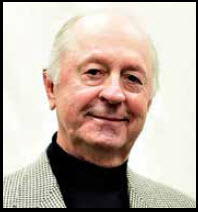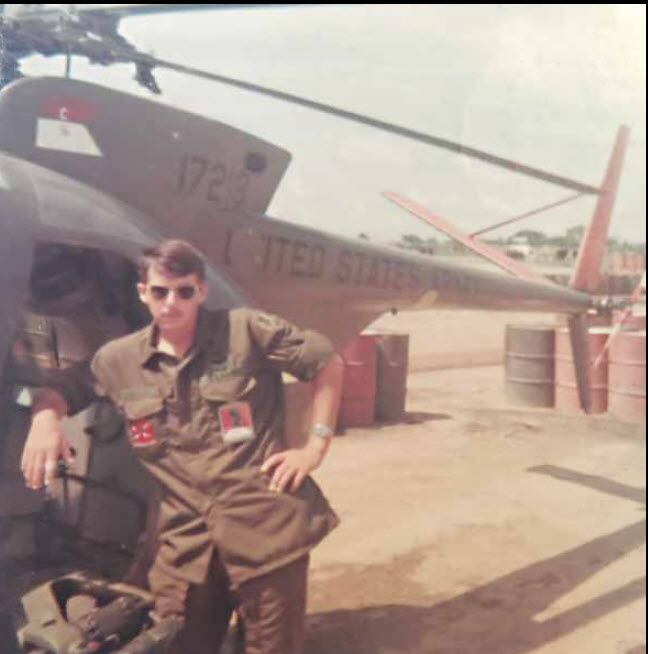Twelve Lives of “Crash Baker” Part I – Jerry’s Journal
 By: Jerry Barksdale
By: Jerry Barksdale
If you met Hal Baker walking near his home on East Street in Athens, his unassuming appearance and quiet demeanor wouldn’t hint that he holds two Purple Hearts, a Silver Star and seven other medals for heroism in battle. To my knowledge he is the most decorated Vietnam veteran in Limestone County.
Baker has to be the luckiest, unlucky helicopter pilot that ever flew in the Vietnam War. His call sign was “Darkhorse one-three” and his nickname, “Crash Baker.” A sign in the operations room stated, “Fly with Crash Baker at your own risk.” He survived 3 crashes and went down a total of 12 times, 9 of which he was shot down. Cats must be envious of Baker.
Harold “Hal” Gene Baker and his twin brother, Carold were born on July 3, 1948 in a share cropper’s shack in a cotton patch near the small Arkansas Delta town of Swifton. He was too young to pick cotton, but not too young to ride his mother’s sack while she picked. Times were hard. His father moved the family north to Indianapolis seeking work when Hal was three years old. His interest in flight came early in life. When he was a first grader, he jumped out of a barn loft. Being unlucky, he severely injured his hip requiring traction for 6 months and crutches for 2 ½ years.

After graduating high school, he worked for Allison Motors manufacturing airplane props. He yearned for adventure. In the dead of winter, February 1968, at age 19, he joined the Army and was sent to Ft. Leonard Wood, MO, for basic training. “Ft. Misery” he calls it. Afterwards, having received a top secret security clearance, he was assigned to Cryptographic School, Ft. Meade, MD. He didn’t like it. “We were to be located in a small compound in Vietnam guarded by MPs,” says Baker. “If our compound was overrun by enemy, the MPs were supposed to destroy all crypto-equipment and kill the personnel. I didn’t think much of that.”
Living on the edge made Baker feel alive. He completed parachute school at Ft. Benning, and was assigned to the famed 82nd Airborne Division. Meanwhile, he tested for both the Green Berets and Flight School. “I weighed wading through rice paddies versus flying over them.” He chose flight school.
Unlike the other services, the Army didn’t require pilots to have a college degree. Baker was accepted and began 9 months of primary flight training, the first half at Ft. Wolters near Mineral Wells, Texas. It was brutal and the harassment never ceased. “We weren’t allowed to look up at a helicopter when one flew over,” he says. Then on to Ft. Rucker, Alabama, where he graduated and was commissioned warrant officer.
Following a 30-day leave, Baker flew to San Francisco, headed to war. The United flight attendant moved him up to first class. “I told one of the young hostesses that I wanted to see the Golden Gate Bridge before I died, that I was going to Vietnam and had no expectations of coming home. She drove him across the Golden Gate at 2 a.m. “That’s the nicest we were ever treated.” He adds, “Coming home from Vietnam wasn’t all that great.”
On February 17, 1970, Baker landed at Long Binh, a mosquito infested wet area in the Mekong Delta not far from Saigon. “I woke up next morning never to forget the smell,” says Baker. “It was damp and mildewy and smelled like a rice paddy.” Roads were clogged with motor scooters darting through the streets. The appearance was peaceful but deceiving. Soon, he would learn that it was a smelly green hell where ordinary looking people wanted to kill him. Over 40,000 Americans had been killed in the conflict to date. The average life expectancy of a chopper pilot was 19 minutes. By war’s end, almost half of the 12,000 helicopters sent there were lost, and approximately 5000 pilots and crew members were killed. That doesn’t include those injured.
A few days after arriving, Baker was assigned to the 162nd Aviation Assault Company at Can Tho. Initially, he flew a “Slick” (transport chopper without external weapons) often ferrying combat troops to “hot” landing zones. “I was scared to death,” he says. Later, he flew a Huey gunship armed with 72 rockets and machine guns manned by two door-gunners whose job was to suppress enemy gunfire. There were no gun sights on Hueys. The pilot marked an X on the windshield with a grease pencil and flew toward the target from 1500 feet, firing. “Below 500 feet you couldn’t pull out,” says Baker. “Some pilots got “target fixations” and flew into the ground and were killed.”
Bad luck stalked Baker, but good luck always saved him. The first time he was shot down was while inserting South Vietnamese troops on the ground. They began taking enemy fire. Baker went in to cover them, and his rotor blade was hit by AK- 47 rounds. The blade began shaking, and he went down behind enemy lines and was rescued. His luck held.
The pilots had to operate within strict rules of engagement. “I got in more trouble about that that than anything else,” says Baker. At the end of the runway at Can Tho, was an enemy bunker. “They shot at us in the morning when we flew out and when we came back in the afternoon. We couldn’t return fire. One evening I flew over and saw five enemy soldiers.” He rolled in and squeezed the trigger, killing three or four. The door-gunner was shot in the foot. He called for Cobra backup, but they told him he had to quit. “I kicked out the radio and told them I didn’t know what they were saying. Finally, I ran out of bullets and quit.” He grins, “I got chewed out.”
On another occasion after completing a firing mission, with two rockets left, Baker decided to practice on two water buffalo near a tree line. They swooped low and opened fire. Suddenly, bullets ripped into the flight control. “We splashed down by a dike on the other side of a rice paddy,” says Baker. “One of the door-gunners jumped up on the dike like John
Wayne and raked the tree line with bullets.” The enemy zeroed in on him. Baker, armed with only a .45 pistol, was no match for AK-47s, and moved away from the targeted machine-gunner. The fire fight lasted for 45 minutes, but again luck intervened. A recovery chopper from Can Tho rescued them.
A close friend invited Baker to join a “Hunter-Killer” team which consisted of 5 choppers. Two Cobra gunships armed with rockets, mini-guns on the nose, and a door-gunner, flew overhead at 1500 feet. A Huey flew at 1000 feet and acted as command and recovery. Baker’s 5’9”, 165 pound frame fit nicely into one of the two Loaches (light observation choppers) that flew no more than 10 feet above the ground. They were scouts looking for targets. His door-gunner, attached to a “monkey strap,” hung out the door and manned an M60 machine gun. It was dangerous and very stressful. The Hunter-Killer team averaged killing 120 enemies a month. “Our life expectancy as a Loach pilot was 11 seconds after we made contact,” says Baker. “We flew two missions a day for 3 days, then off.” However, most of the time he didn’t take his off days. Instead, he flew door-gunner or front seat on a Cobra gunship. “I figured if anybody was going to get killed, it’d be me,” says Baker. “We were young. I really didn’t care. Most of us didn’t care.”
Often Viet Cong hid in sampan boats in the river. Baker spotted an enemy and went in for the kill. The VC returned fire and shot out the chopper engine. “I splashed down in a rice paddy on the other side of the sampan,” says Baker. “The left skid broke off, and we flipped over.” Again, good luck intervened. The other Loach sank the sampan and rescued Baker and crew.
The first time Baker was wounded by enemy fire was when he was shot down with an M-79 grenade launcher. It was his ninth crash. He had a new door-gunner. They spotted three sampans turned over in the water. Enemy soldiers were hiding beneath them. “Water was so clear at times we could see people on the bottom breathing through a reed. Command and Control wanted to capture and interrogate them.” Baker dropped down to provide covering fire. Suddenly his chopper was hit on the left side knocking out his flight control. “We were going inland. All glass, airframe, everything on the right side was blown off.” It seemed Baker had finally run out of luck. “I stomped the left pedal and we crashed, rolling over, end over end, five times. My door-gunner was hanging on the monkey strap and wounded. I got out of my harness and jumped into the water and unhooked my door-gunner. Bullets were flying everywhere – water splashing around me. I saw blood streaming down my arm and I had been hit, with shrapnel in my arm and leg.” After rescue, they were flown to a hospital where pockets of shrapnel were removed from his body. “I never felt getting shot.”
Afterwards, Baker learned that a turncoat South Vietnamese soldier had fired the M-79 that shot them down. The turncoat was stood up in front of a brick wall and machine gunned by his fellow soldiers. In Vietnam, one never knew who was friend or foe. The barber that cut the men’s hair during the day was a Viet Cong fighter at night. He was killed coming through the barbed wire that surrounded the compound. On another occasion, a “friendly” pulled the pin on a hand grenade, wrapped a rubber band around it to hold the plunger down, and dropped it in the chopper’s gas tank while the crew was temporarily absent. Fortunately, the gas ate through the rubber, and the grenade exploded before the chopper was airborne.
To be continued…
By: Jerry R. Barksdale
www.jerrybarksdale.com fb.com/jerry.barksdale.7
